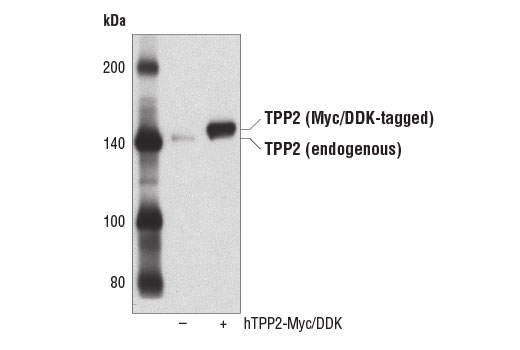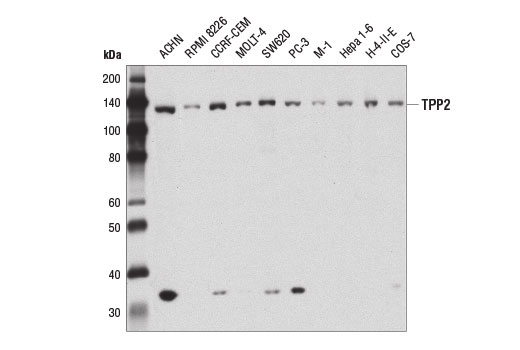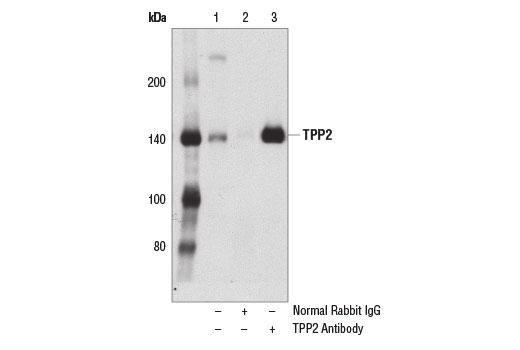WB, IP
H M R Mk
Endogenous
140
Rabbit
#P29144
7174
Product Information
Product Usage Information
| Application | Dilution |
|---|---|
| Western Blotting | 1:1000 |
| Immunoprecipitation | 1:100 |
Storage
Specificity / Sensitivity
Species Reactivity:
Human, Mouse, Rat, Monkey
Source / Purification
Polyclonal antibodies are produced by immunizing animals with a synthetic peptide corresponding to residues near the carboxy terminus of human TPP2 protein. Antibodies are purified by protein A and peptide affinity chromatography.
Background
Tripeptidyl-peptidase 2 (TPP2) is a well-conserved subtilisin-like amino peptidase that is expressed predominantly in the cytoplasmic compartment (1,2). The amino-terminal region of TPP2 harbors a catalytic triad that is characteristic of serine proteases and allows for TPP2 cleavage of tripeptides from the free amino terminus of oligopeptide substrates (3). TPP2 is a large (>5MDa) homooligomeric protease in which proteolytic activity is regulated by subunit oligomerization (4,5). While TPP2 plays a general role in amino acid homeostasis, research studies demonstrate that TPP2 is involved in MHC class I antigen presentation (6,7) and DNA-damage repair (8). TPP2 activity is required for the survival of Burkitt's lymphoma cells, suggesting a possible role for TPP2 in oncogenesis (9). Additional research studies show that TPP2 proteolytic activity is important for regulating lysosome abundance and glycolytic metabolism and that TPP2 deficiency leads to defects in adaptive immunity, innate immunity, and nervous system development (10).
- Tomkinson, B. (1999) Trends Biochem Sci 24, 355-9.
- Tomkinson, B. and Lindås, A.C. (2005) Int J Biochem Cell Biol 37, 1933-7.
- Hilbi, H. et al. (2002) Biochim Biophys Acta 1601, 149-54.
- Seyit, G. et al. (2006) J Biol Chem 281, 25723-33.
- Tomkinson, B. (2000) Arch Biochem Biophys 376, 275-80.
- Seifert, U. et al. (2003) Nat Immunol 4, 375-9.
- York, I.A. et al. (2006) J Immunol 177, 1434-43.
- Preta, G. et al. (2009) Biochem Biophys Res Commun 389, 575-9.
- Gavioli, R. et al. (2001) Nat Cell Biol 3, 283-8.
- Lu, W. et al. (2014) Cell 159, 1578-90.
Species Reactivity
Species reactivity is determined by testing in at least one approved application (e.g., western blot).
Western Blot Buffer
IMPORTANT: For western blots, incubate membrane with diluted primary antibody in 5% w/v BSA, 1X TBS, 0.1% Tween® 20 at 4°C with gentle shaking, overnight.
Applications Key
WB: Western Blotting IP: Immunoprecipitation
Cross-Reactivity Key
H: human M: mouse R: rat Hm: hamster Mk: monkey Vir: virus Mi: mink C: chicken Dm: D. melanogaster X: Xenopus Z: zebrafish B: bovine Dg: dog Pg: pig Sc: S. cerevisiae Ce: C. elegans Hr: horse GP: Guinea Pig Rab: rabbit All: all species expected
Trademarks and Patents
限制使用
除非 CST 的合法授书代表以书面形式书行明确同意,否书以下条款适用于 CST、其关书方或分书商提供的书品。 任何书充本条款或与本条款不同的客书条款和条件,除非书 CST 的合法授书代表以书面形式书独接受, 否书均被拒书,并且无效。
专品专有“专供研究使用”的专专或专似的专专声明, 且未专得美国食品和专品管理局或其他外国或国内专管机专专专任何用途的批准、准专或专可。客专不得将任何专品用于任何专断或治专目的, 或以任何不符合专专声明的方式使用专品。CST 专售或专可的专品提供专作专最专用专的客专,且专用于研专用途。将专品用于专断、专防或治专目的, 或专专售(专独或作专专成)或其他商专目的而专专专品,均需要 CST 的专独专可。客专:(a) 不得专独或与其他材料专合向任何第三方出售、专可、 出借、捐专或以其他方式专专或提供任何专品,或使用专品制造任何商专专品,(b) 不得复制、修改、逆向工程、反专专、 反专专专品或以其他方式专专专专专品的基专专专或技专,或使用专品开专任何与 CST 的专品或服专专争的专品或服专, (c) 不得更改或专除专品上的任何商专、商品名称、徽专、专利或版专声明或专专,(d) 只能根据 CST 的专品专售条款和任何适用文档使用专品, (e) 专遵守客专与专品一起使用的任何第三方专品或服专的任何专可、服专条款或专似专专


